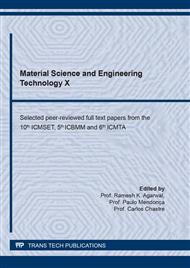p.176
p.185
p.191
p.199
p.205
p.212
p.218
p.225
p.232
Effect of Pore Defect Size and Location on Damage Tolerance of Aluminum Alloy Piston and Fiber Ring Groove
Abstract:
The defects of high-power density piston aluminum alloy components involved in this paper include surface crack, internal crack, shrinkage cavity and cold shut. The service condition of piston components is 350°C-420°C, and the explosion pressure of piston crown is 28Mpa. The requirements for eddy current flaw detection of this component are in accordance with a and requirements in GB / T5126-2013 eddy current flaw detection standard, that is, it is not allowed to be greater than 0.12mm × 0.2mm × 3mm volumetric defects, and Ф1.0mm flat bottom hole equivalent point defect. For the piston components of 88kw / L high-power diesel engine, under the service conditions of temperature 350°C-420°C and piston top explosion pressure 28Mpa. Under the condition of thermal mechanical coupling, the typical NDT defects such as surface crack, internal crack, shrinkage cavity and cold shut of the first ring groove and internal position of the piston are studied. On scale, morphology and position sensitivity and their quantitative relationship. At the same time, numerical simulation analysis combined with relevant experimental verification is used to comprehensively analyze and evaluate the damage tolerance of defects, and scientifically evaluate the defects of different properties and sizes.
Info:
Periodical:
Pages:
205-211
Citation:
Online since:
February 2022
Authors:
Keywords:
Price:
Сopyright:
© 2022 Trans Tech Publications Ltd. All Rights Reserved
Share:
Citation:


